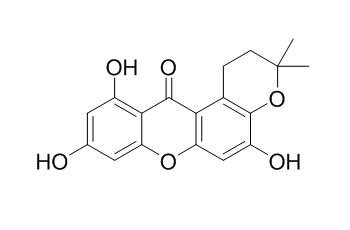Hyperxanthone E
Hyperxanthone E is a phytoalexin from Hypericum calycinum cell cultures.
Inquire / Order:
manager@chemfaces.com
Technical Inquiries:
service@chemfaces.com
Tel:
+86-27-84237783
Fax:
+86-27-84254680
Address:
1 Building, No. 83, CheCheng Rd., Wuhan Economic and Technological Development Zone, Wuhan, Hubei 430056, PRC
Providing storage is as stated on the product vial and the vial is kept tightly sealed, the product can be stored for up to
24 months(2-8C).
Wherever possible, you should prepare and use solutions on the same day. However, if you need to make up stock solutions in advance, we recommend that you store the solution as aliquots in tightly sealed vials at -20C. Generally, these will be useable for up to two weeks. Before use, and prior to opening the vial we recommend that you allow your product to equilibrate to room temperature for at least 1 hour.
Need more advice on solubility, usage and handling? Please email to: service@chemfaces.com
The packaging of the product may have turned upside down during transportation, resulting in the natural compounds adhering to the neck or cap of the vial. take the vial out of its packaging and gently shake to let the compounds fall to the bottom of the vial. for liquid products, centrifuge at 200-500 RPM to gather the liquid at the bottom of the vial. try to avoid loss or contamination during handling.
Hum Exp Toxicol.2023, 42:9603271231171642.
Front Immunol.2018, 9:2091
Biomed Pharmacother.2021, 139:111585.
Asian J Beauty Cosmetol2019, 17(3):287-294
Proc. Sci. Math.2024, V25:108-123
Toxins (Basel).2021, 13(9):593.
South African Journal of Botany2024, 168:209-220.
Int J Mol Sci.2021, 22(14):7324.
Nat Commun.2023 Dec 20;14(1):8457.
Phytomedicine.2021, 83:153483.
Related and Featured Products
Plant Physiol. 2012 Nov;160(3):1267-80.
Cinnamate:CoA ligase initiates the biosynthesis of a benzoate-derived xanthone phytoalexin in Hypericum calycinum cell cultures.[Pubmed:
22992510]
Although a number of plant natural products are derived from benzoic acid, the biosynthesis of this structurally simple precursor is poorly understood.
Hypericum calycinum cell cultures accumulate a benzoic acid-derived xanthone phytoalexin, Hyperxanthone E, in response to elicitor treatment.
METHODS AND RESULTS:
Using a subtracted complementary DNA (cDNA) library and sequence information about conserved coenzyme A (CoA) ligase motifs, a cDNA encoding cinnamate:CoA ligase (CNL) was isolated. This enzyme channels metabolic flux from the general phenylpropanoid pathway into benzenoid metabolism. HcCNL preferred cinnamic acid as a substrate but failed to activate benzoic acid. Enzyme activity was strictly dependent on the presence of Mg2⁺ and K⁺ at optimum concentrations of 2.5 and 100 mM, respectively. Coordinated increases in the Phe ammonia-lyase and HcCNL transcript levels preceded the accumulation of Hyperxanthone E in cell cultures of H. calycinum after the addition of the elicitor. HcCNL contained a carboxyl-terminal type 1 peroxisomal targeting signal made up by the tripeptide Ser-Arg-Leu, which directed an amino-terminal reporter fusion to the peroxisomes.
CONCLUSIONS:
Masking the targeting signal by carboxyl-terminal reporter fusion led to cytoplasmic localization. A phylogenetic tree consisted of two evolutionarily distinct clusters. One cluster was formed by CoA ligases related to benzenoid metabolism, including HcCNL. The other cluster comprised 4-coumarate:CoA ligases from spermatophytes, ferns, and mosses, indicating divergence of the two clades prior to the divergence of the higher plant lineages.
Molecules. 2015 Aug 27;20(9):15616-30.
Molecular Cloning and Characterization of a Xanthone Prenyltransferase from Hypericum calycinum Cell Cultures.[Pubmed:
26343621 ]
In plants, prenylation of metabolites is widely distributed to generate compounds with efficient defense potential and distinct pharmacological activities profitable to human health.
METHODS AND RESULTS:
Prenylated compounds are formed by members of the prenyltransferase (PT) superfamily, which catalyze the addition of prenyl moieties to a variety of acceptor molecules. Cell cultures of Hypericum calycinum respond to elicitor treatment with the accumulation of the prenylated xanthone Hyperxanthone E. A cDNA encoding a membrane-bound PT (HcPT) was isolated from a subtracted cDNA library and transcript preparations of H. calycinum. An increase in the HcPT transcript level preceded Hyperxanthone E accumulation in cell cultures of H. calycinum treated with elicitor. The HcPT cDNA was functionally characterized by expression in baculovirus-infected insect cells.
The recombinant enzyme catalyzed biosynthesis of 1,3,6,7-tetrahydroxy-8-prenylxanthone through regiospecific C-8 prenylation of 1,3,6,7-tetrahydroxyxanthone, indicating its involvement in Hyperxanthone E formation.
CONCLUSIONS:
The enzymatic product shared significant structural features with the previously reported cholinesterase inhibitor γ-mangostin. Thus, our findings may offer a chance for semisynthesis of new active agents to be involved in the treatment of Alzheimer's disease.



